Ergonomics in the distribution center: picking from pallet hazards and solutions
Steps for making workers safer and improving productivity
Get Quote
Pallet racks expand your ability to store more pallets, less expensively, for longer periods. They allow you to utilize the vertical cube for more efficient, higher-density storage. But at the base of each rack, there are ergonomic hazards, where individuals are picking loads directly from pallets. How can you alleviate these problems?
Floor-level or low-level storage locations cause bending and reaching
Potential hazards:
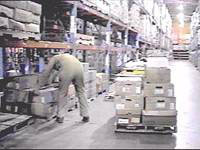
Almost all warehouses utilize the lower (floor) level for pallet storage. It's very easy to plug a pallet into the bay slot on the floor.
This requires employees to bend at the waist to access palletized loads that may be stacked only a few feet high, which is one of the least ergonomic, most physically stressful positions. Even when these pallets are stored in taller slots, employees must bend at the waist to access product.
This is a significant problem since the heaviest product is usually in the shortest stacks.
Loads in bottom bins will require forward torso bending to reach under the rack, even when the top levels of the stack are at waist height or higher. What can you do to relieve these issues?
Potential Solutions:
- Use a pallet positioner or other ergonomic device: Whenever possible, elevate the pallets within a slot bin. The best technique is to place a palletizer into a tall bin. A palletizer will lower in height under the weight of a full pallet, then will raise the load as items are removed. The use of a turntable (also called a Pallet Positioner) allows employees to reposition the load. This keeps the load close to the body.
-
 Stack
empty pallets beneath active ones to raise the pallet level. If your
pallet does not have product stacked above waist height, stack empty pallets
beneath it to elevate the load. Care must be taken so the top level of the
heavy product is not raised higher than mid-chest height.
Stack
empty pallets beneath active ones to raise the pallet level. If your
pallet does not have product stacked above waist height, stack empty pallets
beneath it to elevate the load. Care must be taken so the top level of the
heavy product is not raised higher than mid-chest height.
-
Use
a set-low beam on your pallet rack bays:
Raise the bottom level of racking so loads are
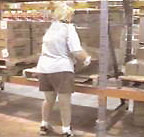 at heights where torso
bending is not necessary. This allows you to rack your pallets
normally by lift truck, and reduce the need for employees to bend over to
access the loaded product. This may require setting your second level beam
higher.
at heights where torso
bending is not necessary. This allows you to rack your pallets
normally by lift truck, and reduce the need for employees to bend over to
access the loaded product. This may require setting your second level beam
higher.
- Use a mobile vacuum hoist to lift products: A forklift with a built-in vacuum hoist can remove the human factor from manual lifting. The strong suction can lift up to 150 lbs. (Check with hoist manufacturers to confirm load capacity).
High Location Storage - picking product above the shoulder level is an ergonomic hazard
Potential Hazard
 Reaching
up is an ergonomic
danger. Employees often reach above shoulder height to access products on
upper rack shelves.
Reaching
up is an ergonomic
danger. Employees often reach above shoulder height to access products on
upper rack shelves.
Aside from the dangers of positioning your body beneath a pallet load where other cartons or other pieces may fall, this causes stress to the shoulders and back. Lifts above shoulder height often require awkward hand and wrist postures, which exacerbate the problem.
Potential Solutions
- Store it higher on your racking—out of hand's reach: Use elevated rack locations as the overstock storage area. Pallets of product should be lowered to more appropriate heights prior to being selected. Selections should be performed with arms close to the body. This way, employees cannot over-reach for a product. They must use a forklift to access it at all, and best lifting practices are more likely to occur.
- Use a Pick Stick: Provide employees with "Pick Sticks" or "Bow Peep" hooks to pull small, light-weight product closer to the edge prior to lifting.
Double or Triple Slot Picking
Potential Hazards
Double or triple slotting is used to maximize shelving space so the greatest amount of product can fit in the smallest amount of space may increase ergonomic stressors such as bending and elevated reaches, as pickers cannot easily access tightly stored items. Most pallet rack is double-slotted. Workers may be forced to bend at the torso to reach under low racking to access product. This product may be stacked at desirable heights that would not otherwise, if not for racking interference, require workers to bend at the torso. Workers must reach above shoulder height to access materials placed on three-tier racking or to access tall, palletized loads placed on two-tiered shelving. In general bottom and top racking in three tiered systems creates significant access issues.
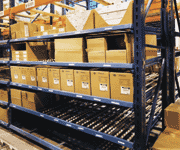 Potential Solutions
Potential Solutions
- Utilize full slotting, especially for product that is heavy or bulky, so employees can have better access without undue reaching or bending.
- Utilize Flow Storage: Slower moving product that is fairly compact can be warehoused using gravity fed flow racks. These racks allow highly condensed usage of warehouse space. However, hazards can be created by this type of racking since it must be loaded by hand from the back of the rack. This can require repeated elevated reaches, repeated bending of the torso, as well as using box openers to cut open shipping boxes. Also, Selectors must pull product over the stop lips that keep the product from sliding out onto the floor. Heavy product in the slot creates additional pressure when lifting boxes over the stop lips. You can overcome these issues with an ergonomic flow rack design that takes them into consideration.
Reaching into pallets for product picks
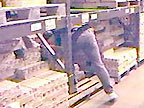 Potential Hazards
Potential Hazards
Product is often removed from the front of pallets first. This leaves the remaining product stacked in the back of pallets, where employees must reach to access and lift product. This creates additional stress on the shoulders and back.
Possible Solutions:
- Rotate the pallet on a regular basis: Develop a product rotation process where pallets are regularly turned using a forklift or pallet truck after the majority of product has been removed. This involves pulling the pallet out of the slot, turning it 180 degrees and replacing it into the slot.
- Utilize storage methods that allow pallets to be moved: Roller and channel devices (such as pallet flow) allow the pallet load to be pulled out for better access. Addition of a turntable at the end of such a device will allow the pallet to be turned and then replaced into the slot with the load closer to the front.
- Widen the storage slots to improve access: Provide wider slots, especially for heavier product, so pickers can walk into the slot and access all sides of a stored pallet. Stockers should be trained to leave at least 16 inches between pallets so there is enough space for Selectors to move around the pallet during selection.
Aisle width
Congested aisles cause product to be hand-carried longer than it should be, or be accessed from incorrect positions
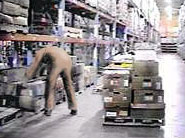 Potential Hazard:
Potential Hazard:
Aisle width may be insufficient for access to faster-moving product. This may create congestion that forces pickers to stop farther from the pick slot and carry product longer distances to the pallet jack. They may be tempted to carry multiple parcels at the same time to save trips.
Possible Solutions:
- Widen the aisle: Increase the width of aisles where fast-moving product is located. This will allow more pallet jacks to get closer and will reduce the distance that loads must be carried.
- Schedule for access: Stagger the start times for Selectors at the beginning of the day so that fewer Selectors hit the same slots at the same time. Five to ten minute start differentials should provide adequate spacing for sufficient disbursal of Selectors.
This article can be found in its original place at the OSHA website.



